Sending emails has evolved from a way to stay in touch with friends and family to an essential business tool. The right email marketing software lets you create and send campaigns that reach the right people with relevant messages.
If you’re looking for the best email marketing software, you’ve come to the right place! In this guide, we’ll break down the top nine tools and tell you everything you need to know to choose the one that’s right for your business.
Table of Contents
Best Email Marketing Software 5th Edition
Here’s our verdict of the 10 Best Email Marketing Tools for 2022:
- ActiveCampaign – best overall email marketing software
- HubSpot – a good option for B2B service companies
- Sendinblue – a good option for transactional email
- Drip – a good option for e-commerce businesses
- Omnisend – another good option for e-commerce businesses
- Autopilot – a good option for advanced marketing automation
- Benchmark – a good option for agencies
- MailerLite – a good option for personal projects
- ConvertKit – a good option for bloggers
- EmailOctopus – a good option for developers
Read on to find out what our survey and testing revealed about each tool’s strengths and weaknesses across nine areas; cost, deliverability, integrations, ease-of-use, reporting, security, features, CRM, and support.
______
#1 ActiveCampaign
Best overall email marketing software
With over 130,000 customers, ActiveCampaign was the most commonly mentioned tool that survey respondents were planning to choose for email marketing software in 2022.
ActiveCampaign have earned their reputation as a leading email marketing automation tool by focusing on building a world-class product.

ActiveCampaign’s automation builder makes building automations easy, similar to using a flowchart
It’s by far the most advanced email marketing platform in our list, with machine learning and predictive tools enabling marketers to work smarter and deliver higher ROI.
Often credited for pioneering visual marketing automation, ActiveCampaign is impressively intuitive and easy-to-use compared to some of the tools on our list.
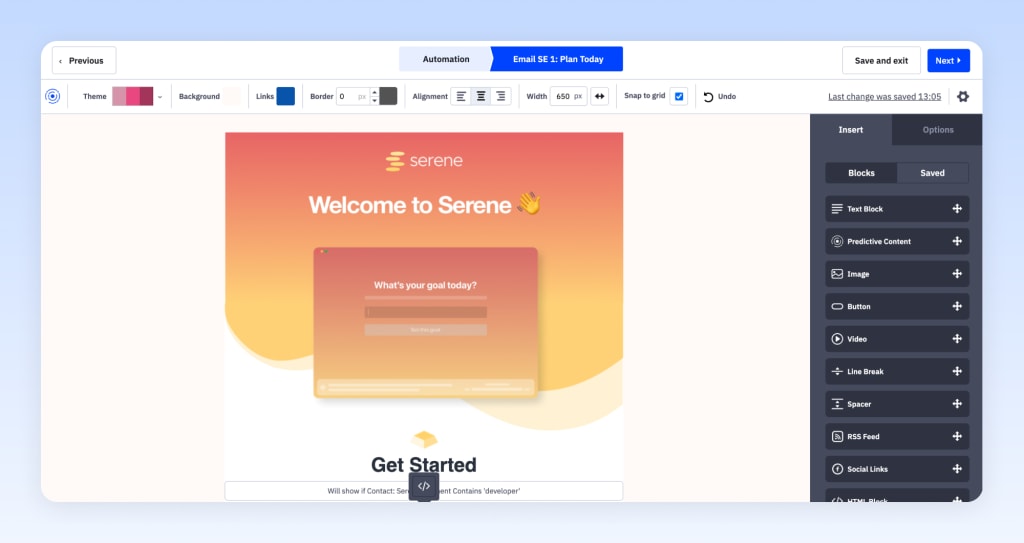
ActiveCampaign’s intuitive drag-and-drop email marketing designer
And while the tip of the iceberg that you see with ActiveCampaign is category-leading, so is what’s below the surface. Their deliverability rates are exceptional (>99%), they integrate with 870+ third-party tools, and go far above and beyond with their security and compliance measures.
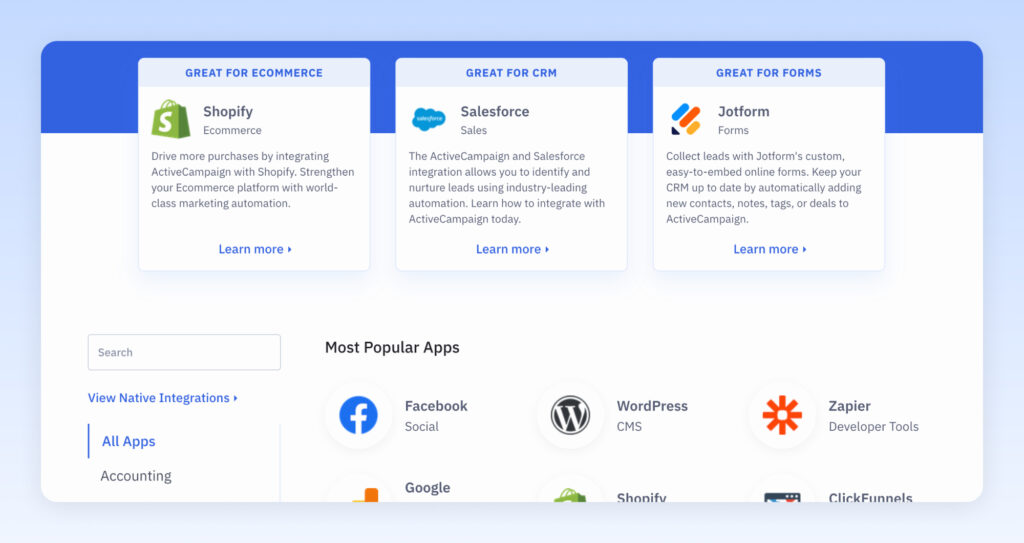
ActiveCampaign offers 870+ integrations including native integrations with Salesforce, Shopify, Google Sheets, Slack & more.
As an all-in-one sales and marketing tool, ActiveCampaign comes with an in-built CRM system to manage yours sales, live chat, and of course email marketing automation in one place.
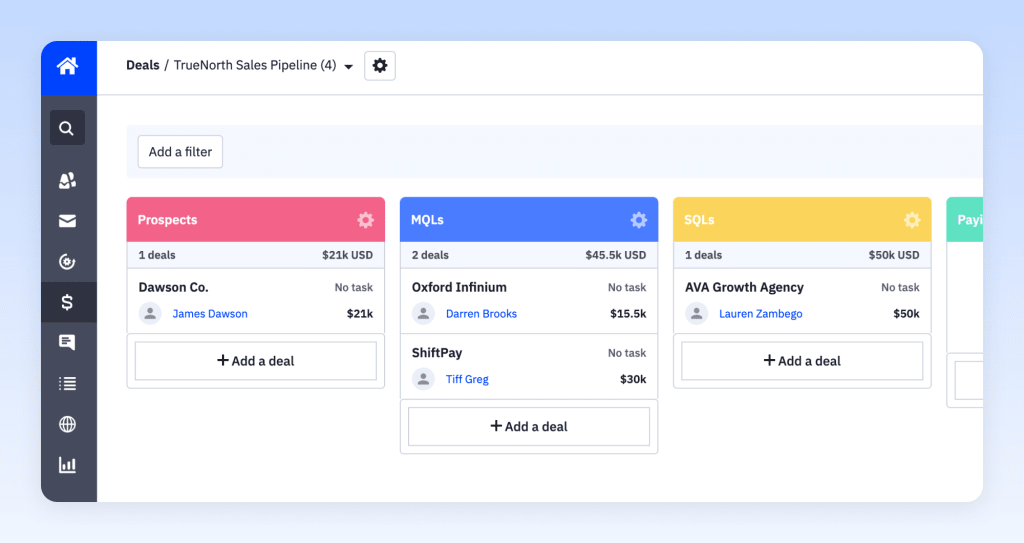
A built-in sales CRM makes it easier to manage deals, but also connects to ActiveCampaign’s powerful automation engine
You’d be forgiven for thinking all of this might come at a hefty cost. Yet, starting at $9/mo, ActiveCampaign is reasonably priced and more affordable than many of the tools in this list.
ActiveCampaign recently published their Customer Success Commitment, which outlines 22 guarantees from their support team including free implementation and migration.
ActiveCampaign’s notable features:
- 125+ Email templates
- 500+ Automation recipes
- 870+ Integrations
- Send SMS, site messages & email
- Landing pages
- CRM
- Split actions and A/B Testing
- Goal tracking, attribution & sales analytics
- Predictive content, sending & deal win probability
ActiveCampaign offers a free 14-day trial with no credit card required.
#2 HubSpot
A good option for B2B service businesses
HubSpot is world-class in offering businesses an all-in-one sales and marketing platform that includes a CRM, landing pages, email marketing, marketing automation, chat, forms, and everything in between.
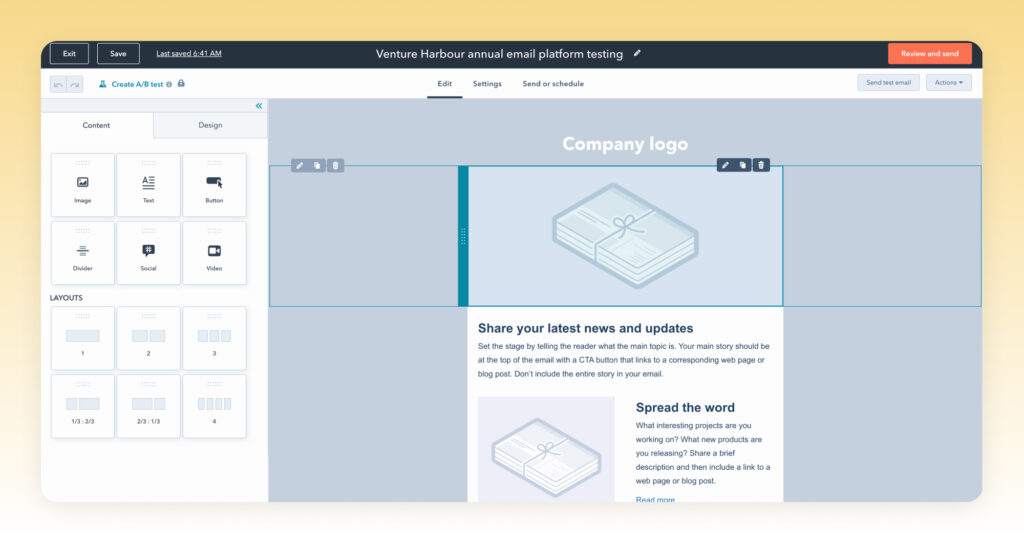
While some argue that trying to do everything is HubSpot’s downfall, it does enable them to do one thing exceptionally well; Reporting.
“Half the money I spend on advertising is wasted; the trouble is I don’t know which half.”
– John Wanamaker
By using HubSpot as the backbone of your marketing and sales, you can more easily attribute revenue back to the marketing campaign, newsletter, or blog post that influenced each sale. In this sense, HubSpot is more of a CRM that offers email marketing and automation, rather than vice versa.
And if your website is built on WordPress, then you get an extra advantage to using HubSpot as your email marketing tool. HubSpot has a WordPress plugin that gives you the ability to send email campaigns directly from WordPress. The plugin also lets you use a HubSpot form or chat widget to automatically capture contacts in your CRM, all without leaving WordPress.
Hubspot can come at a cost
While much-loved, HubSpot is the second most likely response (behind Mailchimp) to “Which email marketing software are you leaving?” in our survey of 1,700+ email marketers. The reason is almost always the same; Price.
HubSpot position themselves as an affordable option for small businesses by offering free versions of their products – but don’t be fooled by the HubSpot gateway-drug. Their platform becomes exponentially expensive as your list or feature requirements grow.
One business owner I spoke with started on a $50/month plan, and within a year needed a $2,000/month plan that had to be paid annually. The only difference was an extra 15,000 contacts and adding marketing automation, yet they jumped from seeing $50 leave the bank to $24,000.
This is where I feel conflicted about HubSpot.
On the one hand, you could get the same functionality for one-tenth of the price using ActiveCampaign, Benchmark, or half of the tools in this guide. On the other hand, if the value of knowing what influenced each sale is a problem worth paying a five-figure sum to solve, then HubSpot is a strong contender.
This is why we suggest that HubSpot is an ideal choice for B2B service companies, where the value of winning a handful of extra clients a year would easily cover the cost of HubSpot. This extends to larger, or more sophisticated, agencies that must provide clients with in-depth reports on their marketing funnel.
If you just need email marketing software, HubSpot is possibly overkill. But if your search for email marketing software is part of a wider plan to raise to your marketing game and improve performance across your entire sales and marketing funnel, HubSpot is a strong contender – but don’t expect it to come cheap.
#3 Sendinblue
A good option for transactional email
Sendinblue is best-known as one of the leading transactional email services. Building on this reputation they built an email marketing automation product.
We use Sendinblue to send transactional emails for two of our ventures (Leadformly and Serene), as they’re one of the few email marketing providers with servers in the European Union (which helps with our GDPR compliance) and they have good deliverability rates (we’re currently at 98%).
While I can’t comment on their marketing automation features from first-hand experience, it’s evident from our customer surveys that it’s good, but lacks some of the more advanced features (such as goal tracking, native integrations, and annotations).
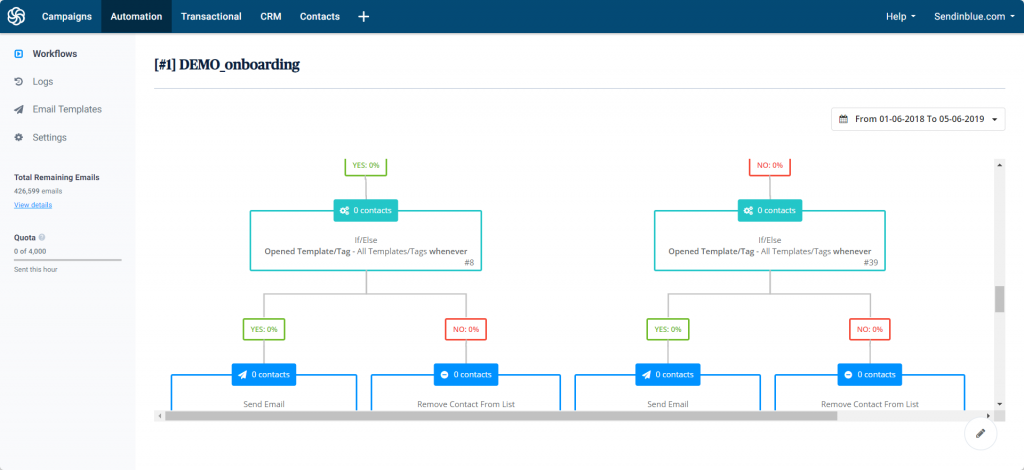
If you need an email marketing tool with a solid API to get your emails into inboxes with a good deliverability rate, Sendinblue’s pre-built developer recipes make it an excellent choice.
What are Sendinblue’s key features?
- Marketing automation
- SMS
- Live chat
- CRM
- Transactional email
- Landing pages
- Sign-up forms
- Facebook Ads
#4 Drip
A good option for smaller e-commerce stores
I think it’s fair to say that Drip’s focus is on smaller to medium-sized e-commerce businesses, whereas our next email marketing tool (Omnisend) seems better suited to the larger e-commerce stores.
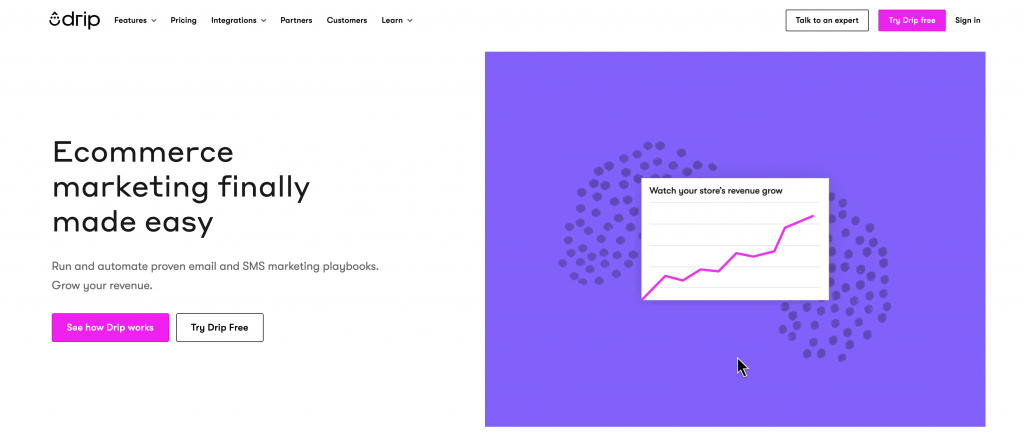
As you’d expect, Drip integrates deeply with all mainstream e-commerce platforms like Shopify, Magento and WooCommerce – as well as the more obscure and custom-made ones.
With built-in revenue analytics and tools to engage customers across multiple channels (from social channels to SMS) Drip is ideally positioned as a powerful tool for growing e-commerce stores.
Their pricing is also palatable, starting at $19/month for small list sizes.
What are Drip’s key features?
- Visual automation
- Email and SMS marketing
- Dynamic e-commerce content blocks
- Discount codes
- e-commerce Segmentation
- Retargeting
- e-commerce store integrations
- Reporting dashboards
- Split testing sequences
#5 Omnisend
A good option for medium-large e-commerce brands
Omnisend is quickly becoming one of the leading marketing platforms for e-commerce stores.
Designed to help e-commerce brands control their marketing across multiple channels, Omnisend offers automated email, SMS, push notifications, and most impressively, integrations with Google Ads, Instagram, Facebook Ads, Messenger, and WhatsApp – which they claim have 10X higher click-through rates than email.
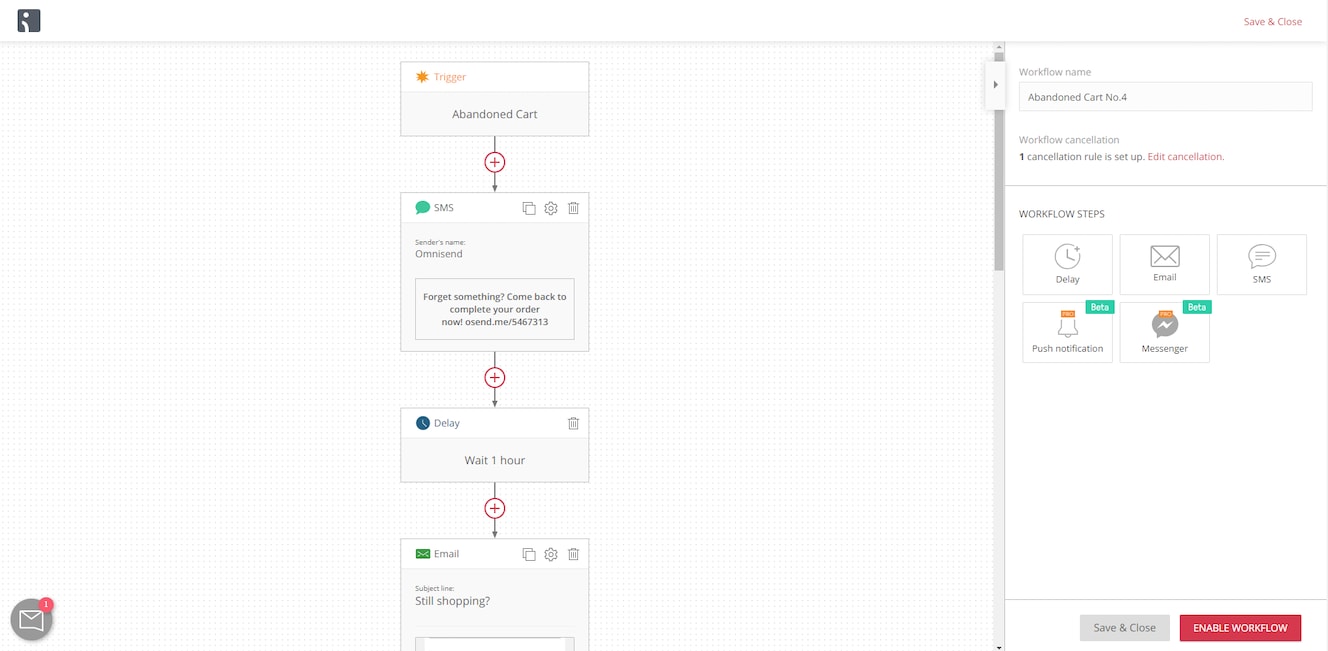
By focusing purely on e-commerce, Omnisend has built innovative email templates designed to reduce cart abandonment and drive repeat buyers. From ‘wheel of fortune’ offers to virtual scratch cards and birthday discounts, it’s evident that Omnisend’s built by a team intimately aware of what works in e-commerce.

As you’d expect of an e-commerce email marketing tool, Omnisend hooks into most e-commerce platforms, including Magento, Shopify, and BigCommerce. Where Omnisend goes one step further is in integrating with review, loyalty and help desk platforms, such as Yotpo, Smile.io, and ReCharge.
This not only enables Omnisend to report on how your campaigns impact sales, but enables you to trigger email, SMS and social campaigns based around your customer behaviour to reduce cart abandonment, increase return buyers, drive more product reviews, and more.
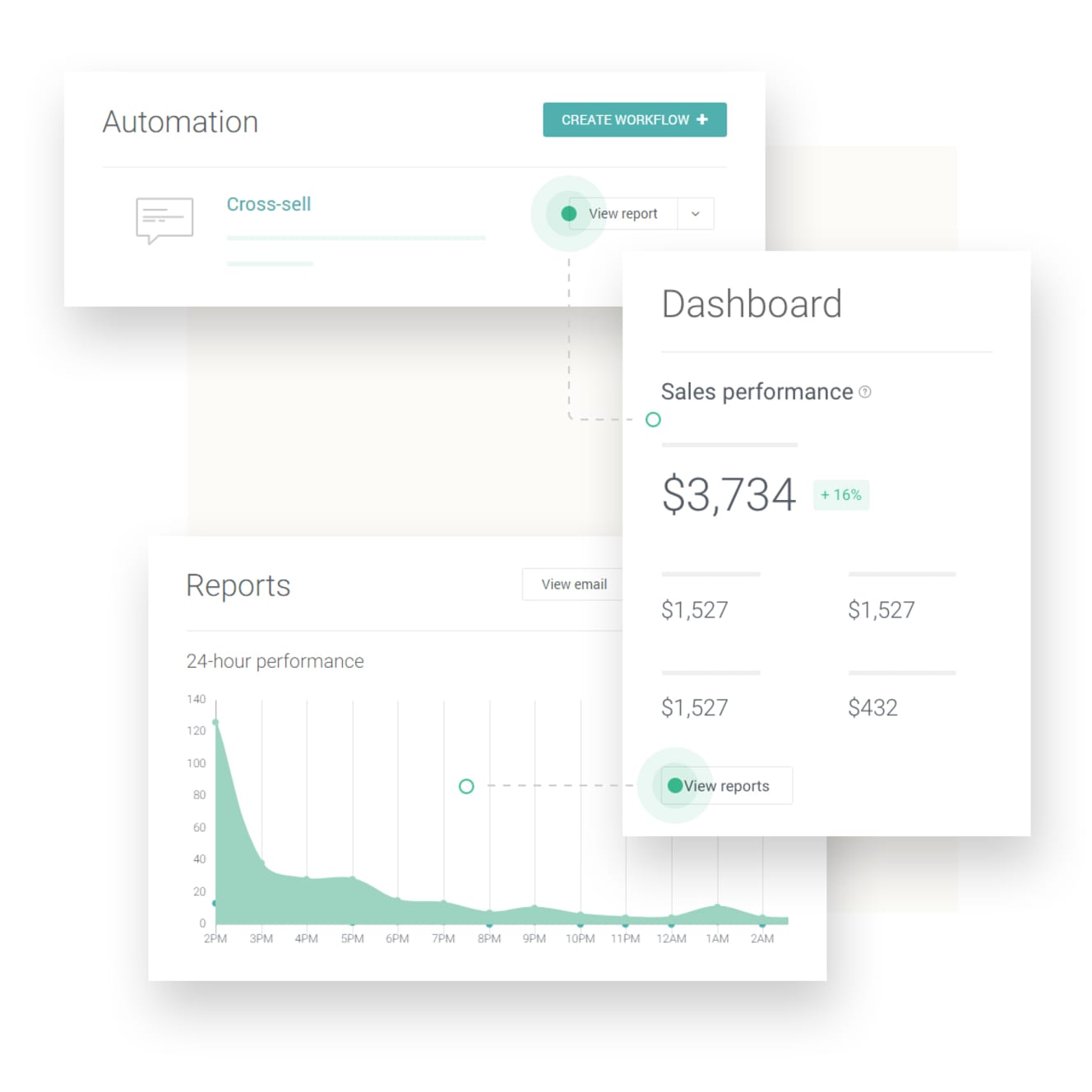
If you want the features that make Omnisend stand out, you’ll need a PRO account which starts at $199/month for up to 10,000 contacts. While not the cheapest, nor the easiest to use, Omnisend is a good option for e-commerce brands that want one multi-channel platform to rule them all.
What are Omnisend’s key features?
- Visual email builder
- Email, SMS and Push notifications
- Transactional and marketing emails
- Dynamic discount codes
- e-commerce Segmentation
- Retargeting
- Surveys and Polls
- Reporting
- Popups and forms – wheel of fortune, scratch cards etc.
- A/B Testing
best free email marketing software
1. HubSpot Email Marketing
HubSpot, probably best known for their marketing automation platform, recently launched a free email marketing tool that can support a lot of a small business’ transactional email needs.
Whether you need to send kickback emails from lead offers, thank you emails after purchase, or just promote current campaigns, HubSpot Email Marketing’s free version can do that. One of the best parts of HubSpot’s free email tool is its ease of use. The tool features a handy drag-and-drop visual editor, and it also comes equipped with ready-made templates to get you up and running immediately.
What makes HubSpot Email Marketing stand out is, of course, its native integration with other HubSpot tools, such as the free-forever CRM. Once you start an account, you get access to both tools so you can create a centralized contacts database, organize it in lists, and manage and track email performance.

2. Sender
Sender is one of the best free email marketing tools in the market with features to ensure deliverability. It lets you create stunning newsletters without any HTML knowledge. Just choose from a template and customize it with elements like images, videos and text. You can even personalize your newsletters for each recipient to create an even bigger impact.

Sender’s robust analytics feature is one of the top reasons why it’s on our list. It lets you track who opened your emails and clicked on the links, when they were opened and more. It even helps you build accurate buyer profiles based on your subscriber actions, so you’ll be able to optimize your existing email strategy and craft compelling offers.
3. Sendinblue
Sendinblue is a marketing communication platform that features both email marketing tools and additional functions such as customer relationship management and landing page creation. With over 70 design templates, Sendinblue’s email design functions make it easy to create a great-looking email. Plus, all of these templates are responsive, and you can preview your results to can ensure your design looks the way you want on any screen format.
After you design your email, you can use features like A/B testing and segmented recipient lists to take the manual effort and guesswork out of optimizing your campaigns and targeting your ideal audiences.

4. Omnisend
Omnisend is a sophisticated ecommerce marketing platform that integrates all your communication platforms in one place. Its free plan includes only email, but it’s more than enough to support the email marketing efforts of small and medium businesses. It allows you to automate your email delivery using behavioral triggers and easily time your communications based on your customers’ convenience.
You can utilize its comprehensive audience insights to send out more relevant email marketing messages. Design attractive newsletters using time-saving features like the Product Picker, which lets you select all the products you want to include in your email. You can also include scratch cards, discount coupon codes and gift boxes to further optimize your email performance.

5. SendPulse
SendPulse advertises itself as a multi-channel marketing platform, but its email marketing feature is the most popular. It comes with a ton of professionally-designed email templates that you can easily customize using a drag-and-drop editor. You can then set up these customized emails to be automatically sent out at the right time based on user behavior, event trigger and other variables.
SendPulse’s subscriber rating feature is an excellent way to identify your most valuable subscribers. It lets you analyze the open and click rates as well as the read and unread rate of each subscriber. You can even set replaceable text fields to personalize your emails by name, gender, date of birth, age and job role.
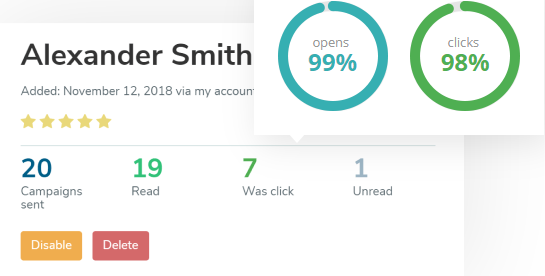
Conclusion
Let us know your thoughts in the comment section below.
Check out other publications to gain access to more digital resources if you are just starting out with Flux Resource.
Also contact us today to optimize your business(s)/Brand(s) for Search Engines
